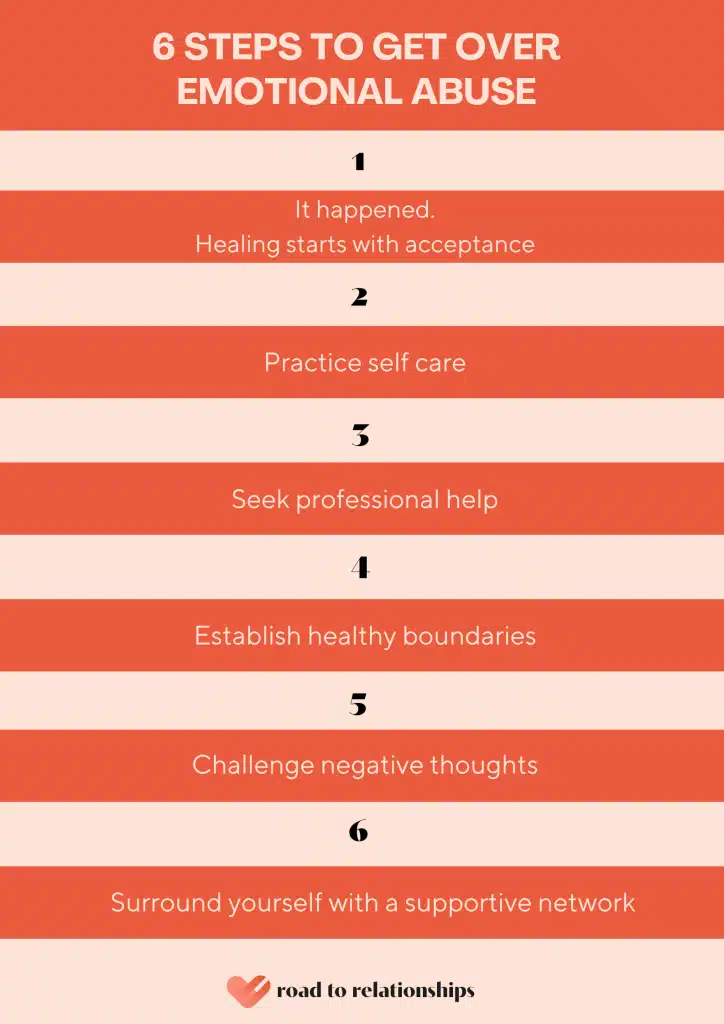
Beste Güneysu Şeker
Contributor

Emma Reliason
Contributor
Beste Güneysu Şeker is a clinical psychologist, while Emma Reliason is a graduate with B.A. in Psychology. Their expertise greatly enriched this article and played a crucial role in our commitment to delivering accurate and informative content.
When we think of abuse, we often picture physical violence. But the truth is, emotional abuse can leave equally lasting scars that are often invisible to the outside world.
Emotional abuse can leave deep wounds that affect one’s mental and emotional well-being. It can take various forms, such as verbal abuse, psychological manipulation, and financial control.
Believe it or not, it can even look like silent treatment or social isolation from friends and family.
Victims of emotional abuse often struggle with their self-esteem, trust, and ability to form healthy relationships in the future.
However, it is possible to heal from the wounds of emotional abuse and build healthier patterns.
Remember, your worth is not defined by what someone else did to you. You are strong and capable, and you deserve love and respect in your life.
Do you want to learn how to get over emotional abuse? Stick around as we delve deeper into overcoming emotional abuse, understanding the healing process, and learning how to establish healthy relationships going forward.
Table of Contents
Many of us grew up hearing the childhood rhyme, “Sticks and stones may break my bones, but words will never hurt me.” The truth is, words can hurt just as much, if not more, than physical blows.
Verbal abuse involves using words to demean, criticize, or manipulate another person. It can erode your self-worth, leaving long-lasting emotional scars.
If your partner belittles you in front of others, ignores your feelings when you express them, constantly criticizes everything you do, or makes unreasonable demands of you, you might be suffering from verbal abuse.
Examples of verbal abuse include:
- Name-calling
- Insults
- Humiliation
- Mocking
- Constant belittlement
2. Psychological Abuse: The Invisible Wounds
Psychological abuse in a relationship is a type of emotional blackmail that can damage a person’s self-esteem.
It’s a weapon that emotional abusers use to control and manipulate their partner through mental anguish. This type of abuse might not be visible on the surface, but make no mistake – its effects can be devastating.
Psychological abuse is characterized by manipulating a person’s mind and emotions.
It is so harmful because it chips away at a person’s sense of worth and self-belief over time, making them feel like they’re never good enough.
It can take the form of constant criticism, name-calling, or even withholding affection. One of the most common and most harmful forms of psychological abuse is called gaslighting.
But what exactly is gaslighting?
Gaslighting refers to a type of emotional abuse where the abuser tries to manipulate the victim to doubt their own reality and sanity.
In a toxic relationship, this can take many forms, such as if your partner constantly questions your memory or perception of events.
Let’s take John and Hannah as examples. John may say things like “I never said that” when Hannah clearly remembers him saying something hurtful about her weight. Or when John makes Hannah doubt her judgment by insisting that things are different than she remembers.
Over time, this can make you feel like you can’t trust your thoughts or feelings and can be incredibly damaging to your mental health.
No, your partner doesn’t have a faulty memory. Gaslighting allows them to avoid taking responsibility for their behavior and makes them feel like they’re the problem.
3. Sexual Abuse: Violation of Boundaries

Sexual abuse involves unwanted sexual behavior imposed on a person without their consent. It can occur in an intimate relationship or even in the context of emotional abuse.
It is important to understand that sexual abuse can happen to anyone, regardless of their gender or sexual orientation.
Sexual abuse in an emotionally abusive relationship can manifest in various ways, but what’s common across all instances is the presence of power dynamics skewed heavily in favor of the perpetrator.
In such relationships, the abused partner may feel trapped, scared, and unable to speak up for themselves, which adds to the trauma they already experience.
This type of abuse may include:
- Non-consensual sexual contact
- Verbal degradation
- Humiliation during intimate moments
- Threats and coercion to engage in sexual activity
These actions are often used to exert power and control over the victim, leaving them traumatized with feelings of helplessness.
Recognizing and acknowledging sexual abuse is crucial for healing and moving forward.
4. Financial Abuse: Controlling Finances and Independence
Financial abuse is a subtle but extremely devastating form of emotional abuse that can be difficult to detect.
Financial abuse occurs when an abuser controls the victim’s finances, restricting their access to money and resources. This type of abuse can leave victims feeling trapped and dependent on their abuser, making it challenging to escape the abusive situation.
For example, an emotional abuser may control all the money, force their partner to account for every penny spent, or refuse to give them access to financial resources, like bank accounts or credit cards.
It can be hard to recognize if it’s happening to you, but some other signs include your partner making you feel guilty for spending money, forcing you to sign financial documents, or not allowing you to make financial decisions on your own.
“I had a friend who was in a relationship where her partner controlled all of the finances. She was not allowed to have a job, and he regularly monitored her spending. He even prevented her from purchasing basic necessities like toiletries and feminine hygiene products because he felt they were “unnecessary expenses.” It wasn’t until my friend confided in me and sought outside help that she realized what was happening to her.”
Emma Eliason, Writer and Psychology Major at the University of Minnesota
Consulting with family and friends is crucial for our mental and emotional well-being. They can give us the support and encouragement needed to leave our abusive partner.
They can also offer a fresh perspective on the situation and help us recognize the patterns of abuse. More importantly, they can remind us of our worth and that we deserve better.
Understanding the Cycle of Abuse
Emotional abuse is a complex issue that can manifest in different relationships.
Understanding the cycle of abuse and its impact on your mental health is the first step towards healing and breaking free from the toxic cycle.
The cycle of abuse typically follows a consistent pattern that includes:
- A tension-building phase: It is characterized by growing discomfort, walking on eggshells, and waiting for the inevitable conflict.
- An explosive or abusive incident: This stage is when the abuser usually launches verbal or physical attacks.
- A period of remorse or reconciliation: An abuser might apologize, promise to change, and shower their partner with affection.
- A calm or honeymoon phase: This is the temporary peace and tranquility that follows a cycle of violence, manipulation, and domination. The victim may feel relieved, hopeful, and optimistic that things will be different this time. However, be aware of exaggerated affection in hopes of turning things around. While it may feel nice, it might also simply be a show.
Knowing how to get over emotional abuse requires that you recognize this cycle, as it is essential for understanding the dynamics of the abusive relationship and breaking free from it.
The Healing Process: 6 Steps to Recovery

Ending an emotionally abusive relationship can be an incredibly difficult and trying experience. It can leave you feeling drained, hurt, and incapable of moving forward.
But let me tell you, there is hope. There is a way to heal and recover from the pain you’ve experienced.
In fact, there are six steps that you can take to reclaim your life and move forward in a positive, healthy way.
If you’re ready to overcome the emotional scars left behind by an abusive partner, then keep reading to learn more about the journey of recovery. Together, we can start your journey towards healing and happiness.
Here are some essential steps in the healing and recovery process:
1. Seek Professional Help
The emotional scars can remain long after you’ve parted ways with your partner, making it challenging to move on and find closure. That’s why seeking professional help from a therapist can be so valuable in these situations.
A therapist can provide you with a safe and supportive space to explore your emotions and work through the trauma you may have experienced.
They can assist you in identifying negative thought patterns, developing coping mechanisms, and rebuilding your sense of self-worth. Through therapy, you can learn to heal from the damage inflicted upon you and move forward toward a happier, more fulfilling future.
2. Establish Healthy Boundaries
Sometimes, we put ourselves in situations where we feel compelled to meet the needs of others and where we become emotionally exhausted. Setting healthy boundaries is crucial for protecting yourself from further harm and developing healthier relationships going forward.
But why is this so important?
Beste Güneysu Şeker, clinical psychologist and our resident expert states that saying “no” might sound like a small thing, but it’s actually a powerful tool that lets others know you’re serious about taking care of yourself. We might feel guilty or selfish for putting ourselves first, but it’s actually the key to building better relationships, including the one you have with yourself.
“That’s why it’s important to consider our emotions, say no, and trust ourselves while determining our limits. We should not forget that emotions are like roadside signs; they’ll show you the way you’re supposed to go,” she adds.
However, drawing borders should not mean stonewalling or getting angry. If you’re worried about setting boundaries, you can start by asking yourself and answering these five questions first:
- Who am I?
- What do I want?
- Who is the other party?
- What does the other person want from me?
- What can be done about it?
3. Surround Yourself with a Supportive Network
Building a network of supportive friends and family members is crucial for healing from emotional abuse.
This is because having a safety net of people who understand what you’re going through can help you avoid feelings of isolation, which is common among abuse survivors.
Your journey to healing from abuse is unique, but having people to lean on can make a world of difference.
This network could include trusted friends, family, or a therapist, but the most important thing is to surround yourself with people who will offer a listening ear, encouraging words, and a shoulder to cry on when necessary.
Sometimes, it takes a village to heal, but with a supportive network in place, you can move forward with confidence and strength.
4. Practice Self-Care and Self-Compassion
“As humans, we show compassion to those around us, including animals and people. However, this can turn into an emotional flood, especially if a traumatic event has occurred. Therefore, there is a fact that we have missed. While we have so much compassion for our environment, we do not have compassion for ourselves. We can develop this state, which we call self-compassion, or conscious awareness.”
Beste Güneysu Şeker, Expert Psychologist

When we’ve been in an abusive relationship, we often feel like we’ve been stripped of our self-esteem and self-worth. It can feel like we’ll never regain our confidence or trust in ourselves.
But practicing self-care and self-love is absolutely crucial for recovery. Without it, we’re more likely to go back into the arms of our abuser because we don’t believe we’re capable of anything better.
Şeker advices a very simple but widely used method for self care and compassion. First, sit in a chair with your feet flat on the floor. Lie on your back to the chair. Keep your body in an upright position, be careful not to strain your body.
Then become aware of your body; feel the hardness or softness of your muscles, the warmth or coldness of your body. Then hug yourself with your arms where you are sitting. Sit with your arms wrapped around yourself for a while and give yourself flattering or flattering compliments. She calls this exercise the self-compassion hug.
What else does self-care and self-love look like?
It could be anything from taking a relaxing bath, going for a walk in nature, meditating, or even just saying kind things to ourselves when we look in the mirror.
In a nutshell, it means engaging in activities that bring you joy, practice self-compassion, and prioritize your well-being.
The point is to treat ourselves with the same love and compassion as you would show a close friend. It won’t be easy at first, but it’s worth it.
5. Challenge Negative Thought Patterns
Have you ever found yourself feeling unworthy or inadequate even though there’s no apparent reason to? Have you ever second-guessed every decision you make, fearing that you might be wrong or that it might upset someone?
If you have, chances are that these are negative thought patterns that stemmed from being in an emotionally abusive relationship.
According to Şeker, our emotional experiences often hold more sway over our perception of events than the events themselves. For example, when we climb the stairs quickly, we probably have a faster heartbeat and sweat, but we don’t think we’re going to die.
If you have a panic attack, on the other hand, you also have a faster heartbeat and sweat. However, in this case, we may think that we will die with the emotional effects caused by the attack, when the physical effects are actually similar. Thus, even if we experience situations similar to the physical situations we experience while climbing the stairs, the meaning we attribute to the event can lead us negative mindset.
Şeker reinstates that this is not only about stair climbing and panic attacks, but also to many other issues that affect emotionally negative thoughts. Abusive experiences can magnify the objectively normal impact of events, which is relevant to understanding the emotional toll of abusive relationships and the long-lasting effects it can have on a person’s mental and emotional well-being.
Working with a therapist or counselor can help challenge and reframe these negative thoughts, fostering a healthier self-perception.
6. Process and Heal from Trauma
Emotional abuse can cause significant emotional trauma. Engaging in trauma-focused therapy, such as Cognitive-Behavioral Therapy (CBT) or Eye Movement Desensitization and Reprocessing (EMDR), could potentially help process and heal from traumatic experiences.
CBT focuses on changing negative thought patterns and behaviors linked to trauma.
Meanwhile, EMDR works by reprocessing the traumatic event through eye movements or other forms of bilateral stimulation.
Building Healthier Relationships
Now that you’ve overcome the challenges of emotional abuse, it’s time to embark on a journey of building healthier relationships.
The following tips will help you navigate this path with confidence and create a fulfilling connection:
1. Learn From Past Experiences
Your past abusive relationship holds valuable lessons. It’s important to take the time to learn from our past experiences so that we can move forward and ultimately build healthy relationships.
One way to do this is by reflecting on what went wrong in the past relationship, identifying patterns or red flags, and working to recognize them in future relationships.
Armed with this knowledge, you can make informed choices and ensure that your future relationships are free from abuse.
2. Take Time for Self-Reflection
Leaving an emotionally abusive relationship is never easy, but it’s a brave step in regaining your power and owning your life. Once you’re out of that toxic environment, it’s important to prioritize self-reflection and give yourself the time to heal and move forward.
Engaging in self-reflection is like looking through a clear lens to understand your needs, desires, and boundaries.
Reflecting on what went wrong and what you can do differently in the future is crucial in breaking patterns and preventing yourself from falling into similar unhealthy relationships in the future.
Invest time in exploring your values and goals and envisioning what a healthy relationship means to you.
It’s also important to remember that healthy relationships are out there and attainable.

3. Communicate Effectively
Open and honest communication is the lifeblood of healthy relationships. Express your thoughts, feelings, and boundaries clearly to your partner, fostering a safe space for both of you to express yourselves authentically.
Emma Reliason shares a helpful tip to achieve this:
“One effective tip for expressing yourself in a healthy way is to use “I” statements instead of blaming or accusatory language. Instead of saying, “You never listen to me,” try saying, “I feel unheard when we don’t communicate effectively.” This takes the blame away from your partner and puts the focus on your own emotions”.
Actively listen and validate your partner’s perspectives, cultivating a strong foundation of trust.
4. Practice Active Consent
In healthy relationships, consent is not only crucial but also actively practiced. Prioritize respecting your partner’s boundaries and ensure that consent is freely given and ongoing.
By practicing active consent, you are creating a safe and comfortable space for yourself and your partner. This not only ensures that boundaries are respected but also fosters mutual trust and respect in your relationship.
This empowers both individuals to feel safe, secure, and in control of their own bodies and choices.
5. Prioritize Mutual Respect
Healthy relationships are built on a foundation of mutual respect. Without it, conflicts and misunderstandings are inevitable.
Treat your partner with kindness, empathy, and equality, valuing their needs and desires as much as yours. Embrace a partnership where both individuals feel seen, heard, and valued.
One great tip is to take the time to acknowledge and appreciate your partner’s strengths and qualities. Maybe they’re a great listener, super supportive, or have an infectious sense of humor.
Whatever it is, make sure they know you see it and value it.
6. Seek Professional Help, If Needed
Navigating relationships after emotional abuse can be challenging. If you struggle or need guidance, don’t hesitate to seek professional help.
A therapist can provide invaluable support in working through any lingering trauma or relationship challenges you may encounter.
According to Şeker, therapy is a process of discovery that enables you to realize your feelings, thoughts, perspective on life, beliefs, and attitudes about yourself and others, and the unconscious driving forces that you are not even aware of in daily life.
The focus of the therapy process is change.
The therapist takes your hand and takes on a journey with you. On this journey, they don’t leave you suddenly at your destination, but they accompany and support you along the way.
Conclusion
Learning how to get over emotional abuse is a complex and challenging journey.
However, recognizing the signs, seeking support, and engaging in healing are essential steps toward reclaiming your life and establishing healthier relationships.
Remember, you deserve to be treated with respect, kindness, and love.
By setting healthy boundaries, practicing self-care, and seeking professional help, you can overcome emotional abuse and create a fulfilling life filled with positive and nurturing relationships.







